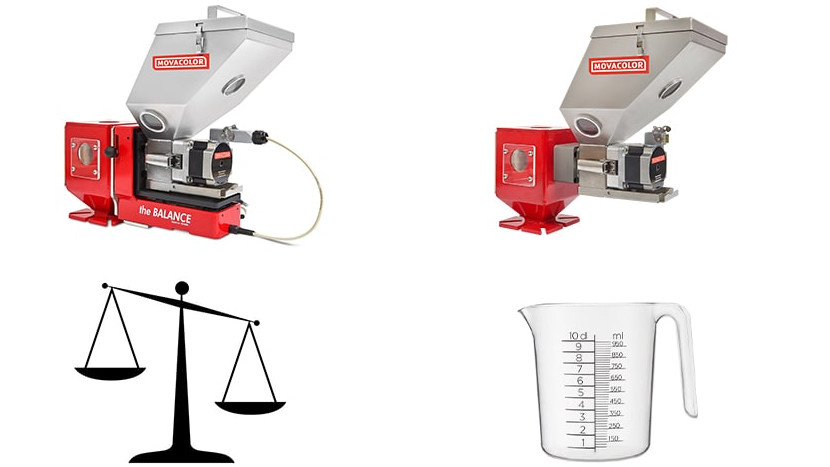GRAVIMETRIC FEEDER VERSUS VOLUMETRIC FEEDER

At first glance, you might think that a gravimetric feeder and a volumetric feeder are very similar. And that's logical – after all, both have been developed for in-line additive dosing at a desired speed in the main stream of an injection molder or extruder. Both dosage systems are furnished with a hopper, neck piece, controller, stepper motor, and dosage cylinder or screw feeder. In terms of speed, Movacolor's stepper motors have a range of 0.1 to 200 rpm and therefore can be set very accurately. In addition, the unique Movacolor dosage cylinder makes sure the additive is dosed in-line in a nice smooth flow of material without pulsations, which produces output of consistent quality.
Features and benefits of a gravimetric feeder?
A gravimetric feeder is a self-calibrating dosing system that doses based on weight in speed. A volumetric feeder, on the other hand, does this based on volume in speed. In gravimetric dosing, the weight of the dosed additive is measured using a load cell that is the foundation of the entire system. Weight is calculated using loss-in-weight technology, which measures the reduced weight while dosing.
In the self-calibrating gravimetric feeder system, the stepper motor automatically alters its speed when a change is detected in the material flow. This eliminates the need for manual adjustment, which is required when using a volumetric feeder. Such a change in material flow can be the result of the addition of new material or fluctuations in the material density, among other factors. This means that, when using a gravimetric feeder to dose, you are in complete control of the quality of your final product. Thanks to the gravimetric feeder's self-calibrating dosing system, you will never run the risk of overdosing and will therefore automatically save costs when using expensive additives.
In addition to the advantages offered by the self-calibrating technology, a gravimetric feeder from Movacolor is easy to operate using the touch screen controller. Movacolor's gravimetric feeder can also be provided with optional monitoring and reporting software. This software allows for close monitoring of the production process for quality management purposes, and any errors in the production process are quickly discovered.
Features and benefits of a volumetric feeder?
A volumetric feeder is a dosing system that supplies the production system with a certain volume of material in a set timeframe, based on the so-called displacement principle. In contrast to a gravimetric feeder, the dosing speed of a volumetric feeder should be selected manually, which may vary based on the nature of the raw input materials. For example, masterbatch requires a different speed compared to dosing of liquid or powder input material.
For smaller production processes and companies who are looking to save on dosing equipment, a volumetric feeder is favoured over a gravimetric feeder. Yet, a gravimetric feeder enables one to save heavily on the input material by a more precise feeding process. This means that a gravimetric feeding system usually provide for a higher return of investment (ROI) on a long-term basis.
Advantages and disadvantages of gravimetric feeder and volumetric feeder?
To summarize, the advantages and disadvantages of a Movacolor gravimetric feeder and volumetric feeder can be concluded in the following way:
Gravimetric feeder
Advantages
- Self-adjusting / self-calibrating
- 100% control over your product quality
- Easy to operate
- Monitoring and reporting options
- Higher saving on expensive additives
- Fluctuations in density do not effect outcome
- In-sensitive to material build-up
- Automatic detection of material supply interruption
- Accurate dosing cylinder
- Stepper motor speed starting from 0.1 up to 200 rpm
Disadvantages
- Relatively more expensive than a volumetric feeder, but short ROI.
Volumetric feeder
Advantages
- Relatively low priced dosing system
- Accurate dosing cylinder
- Stepper motor speed starting from 0.1 up to 200 rpm
Disadvantages
- Manual recalibration required
- Limited control over your product quality
- No monitoring and reporting options
- Cannot automatically compensate for fluctuations in density
- Sensitive to material build-up
- No automatic detection of material supply interruption
Conclusion: When should you select a gravimetric feeder and when is it best to use a volumetric feeder?
To be able to choose wisely between a gravimetric feeder and a volumetric feeder, it is important to know the budget and objective of the user. As mentioned previously, both dosing systems from Movacolor have a stepper motor and a unique dosing cylinder. However, volumetric dosing systems are relatively inexpensive to acquire in the short term, which makes for a low immediate investment. Gravimetric dosing systems, on the other hand, are more expensive to purchase, but you will save on expenses in the long run due to the clearly lower use of expensive additives.
Movacolor has a wide range of gravimetric and volumetric feeders that are tailored to and exceed a producers requirements. You can find our systems on the products page.

 Material Dosing and Mixing
Material Dosing and Mixing Products Handling and Automation
Products Handling and Automation

